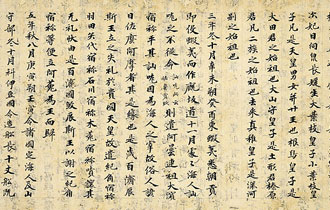Pages |
It is yet another irony of Sokō’s life that his philosophy was to influence the retainers of Asano Naganori. It was the actions of Naganori that were to bring about one of the most famous events in Japanese history, the Akō Incident, better known in the West as the Forty-Seven Rōnin. In 1701, the daimyo of Akō, Asano Naganori (1667–1701) was given the responsibility of handling the arrangements for visiting envoys of the imperial court. He was teamed with Kira Kōzukenosuke (Yoshinaka). One day, Naganori attacked Kōzukenosuke, unable to forgive an insult, the content of which to this day is unknown. Even though Kōzukenosuke only received minor injuries, because Naganori had violated strict rules about drawing weapons within Edo palace, he was sentenced that very evening to commit ritual suicide. His domain was seized and as a result all of Naganori’s vassals were made masterless, or rōnin. Some of them went underground to allay suspicion of revenge. In 1703, a group of about forty-seven (the precise number is disputed) surfaced. They attacked the house of Kira Kōzukenosuke, killing sixteen of his guards and beheading Kōzukenosuke. The Akō rōnin then retired to the Sengakuji Temple, where two days later all participants in the attack on Kōzukenosuke were ordered to commit ritual suicide.
These events are without question the most dramatized of any incident in Japanese history. There have been hundreds of renditions from the first kabuki play produced just three weeks after Kōzukenosuke’s execution (which was immediately shut down) to a film released in December 2013 starring Keanu Reeves. It has also generated thousands of pages of historical research. But more significantly for our discussion, the act of revenge caused active debate among contemporaries as to whether it was an honorable course of action. The Akō rōnin were influenced by the writings of Yamaga Sokō and the story of the forty-seven rōnin has been handed down to us as one of consummate loyalty, a shining example of bushidō, because the vassals never forgot their loyalty to their lord. But their contemporaries were not all convinced of this. Some felt that by violating the oath of fealty that Naganori had made to the shogun, they had committed the greater sin and were to be disparaged rather than admired. It was an existential question for the warrior class as to who their ultimate loyalty belonged to—the lord of their domain or the shogun. Because there was no actual, specific code, there was no clear-cut answer. The story of the forty-seven rōnin makes it clear that the teachings of Yamaga Sokō were not universally accepted by the warrior class during the eighteenth century.
A similarly problematic history surrounds another important text on bushidō, Hagakure by Yamamoto Tsunetomo (1659–1719). As the literal translation of this title “Hidden (or, In the Shadow of) Leaves” might suggest, this text was not widely read during the Edo period. Tsunetomo was a retainer of Nabeshima Mitsushige, whose domain was located on the island of Kyūshū in present-day Saga Prefecture. Although he was a page to Mitsushige as a child, he did not find an official position in the ruling bureaucracy until he was 27, but even this did not last long. Although he was later reengaged, Yamamoto, a generation younger even than Yamaga Sokō, had no experience with war and clearly romanticized the past. This is demonstrated by his desire to commit junshi, the act of suicide upon the death of one’s lord. This practice had never been all that common in Japan until a fad developed in the 1630s. In response, junshi was outlawed in 1663, when Tsunetomo was just a child. Moreover, Mitsushige expressly forbid it. Stymied, Tsunetomo renounced the world and became a Buddhist monk. These facts are relevant in understanding the motivations of the writer and interpreting the text.
Pages |











